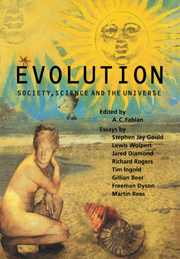Book contents
- Frontmatter
- Contents
- Introduction
- 1 On Transmuting Boyle's Law to Darwin's Revolution
- 2 The Evolution of Cellular Development
- 3 The Evolution of Guns and Germs
- 4 The Evolution of London
- 5 The Evolution of Society
- 6 The Evolution of the Novel
- 7 The Evolution of Science
- 8 The Evolution of the Universe
- Notes on Contributors
- Acknowledgements
- Index
2 - The Evolution of Cellular Development
Published online by Cambridge University Press: 25 January 2010
- Frontmatter
- Contents
- Introduction
- 1 On Transmuting Boyle's Law to Darwin's Revolution
- 2 The Evolution of Cellular Development
- 3 The Evolution of Guns and Germs
- 4 The Evolution of London
- 5 The Evolution of Society
- 6 The Evolution of the Novel
- 7 The Evolution of Science
- 8 The Evolution of the Universe
- Notes on Contributors
- Acknowledgements
- Index
Summary
The evolution of the cell is nature's greatest evolutionary triumph. That may sound rather presumptious when one compares the apparently humble cell with the complexity of organisms such as human beings, with their extraordinary brains. But in evolutionary terms, it was only once the cell had evolved that multicellular organisms became possible. Moreover, I suggest that given the eukaryotic cell – which has a nucleus, contains organelles such as mitochondria, is capable of movement and is itself evolved from the simpler bacteria – the evolution of complex structures, even the brain, was by comparison relatively simple.
Evolution as the modification of development
Development is central to the evolution of multicellular organisms: evolution proceeds by the modification of the embryo's developmental programme to produce differences in the adult. This modification is due to changes in the genes controlling development; they act by controlling cellular behaviour during development. It is by this process that, to use the French molecular geneticist Francois Jacob's phrase, evolution can tinker with embryos, using its bits and pieces to make new structures. This can be seen very clearly when one looks at the early embryos of vertebrates: they all look remarkably similar at one stage (known as the phylotypic stage) and then diverge (Figure 1). Evolution has tinkered with the basic body plan.
A clear example is the limb. While the basic form of the limb has been retained in many land vertebrates, its development has been ‘tinkered with’ to provide the bird's and bat's wings, the horse's leg and our own manipulative hand.
- Type
- Chapter
- Information
- EvolutionSociety, Science and the Universe, pp. 28 - 45Publisher: Cambridge University PressPrint publication year: 1998
- 1
- Cited by



